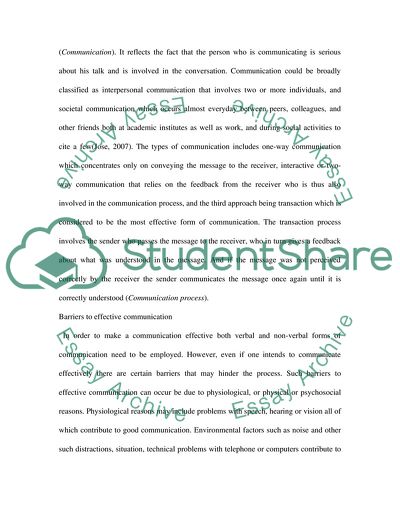Cite this document
(Barriers to Effective Communication Essay Example | Topics and Well Written Essays - 1750 words, n.d.)
Barriers to Effective Communication Essay Example | Topics and Well Written Essays - 1750 words. Retrieved from https://studentshare.org/social-science/1717432-discuss-the-following-statement-in-the-light-of-the-theory-covered-in-this-module-communication-is-not-an-easy-process-it-involves-verbal-non-verbal-attempts-to-assist-the-other-person-to-understand-what-were-trying-to-communicate-yet-it-often-fails
Barriers to Effective Communication Essay Example | Topics and Well Written Essays - 1750 words. Retrieved from https://studentshare.org/social-science/1717432-discuss-the-following-statement-in-the-light-of-the-theory-covered-in-this-module-communication-is-not-an-easy-process-it-involves-verbal-non-verbal-attempts-to-assist-the-other-person-to-understand-what-were-trying-to-communicate-yet-it-often-fails
(Barriers to Effective Communication Essay Example | Topics and Well Written Essays - 1750 Words)
Barriers to Effective Communication Essay Example | Topics and Well Written Essays - 1750 Words. https://studentshare.org/social-science/1717432-discuss-the-following-statement-in-the-light-of-the-theory-covered-in-this-module-communication-is-not-an-easy-process-it-involves-verbal-non-verbal-attempts-to-assist-the-other-person-to-understand-what-were-trying-to-communicate-yet-it-often-fails.
Barriers to Effective Communication Essay Example | Topics and Well Written Essays - 1750 Words. https://studentshare.org/social-science/1717432-discuss-the-following-statement-in-the-light-of-the-theory-covered-in-this-module-communication-is-not-an-easy-process-it-involves-verbal-non-verbal-attempts-to-assist-the-other-person-to-understand-what-were-trying-to-communicate-yet-it-often-fails.
“Barriers to Effective Communication Essay Example | Topics and Well Written Essays - 1750 Words”. https://studentshare.org/social-science/1717432-discuss-the-following-statement-in-the-light-of-the-theory-covered-in-this-module-communication-is-not-an-easy-process-it-involves-verbal-non-verbal-attempts-to-assist-the-other-person-to-understand-what-were-trying-to-communicate-yet-it-often-fails.


